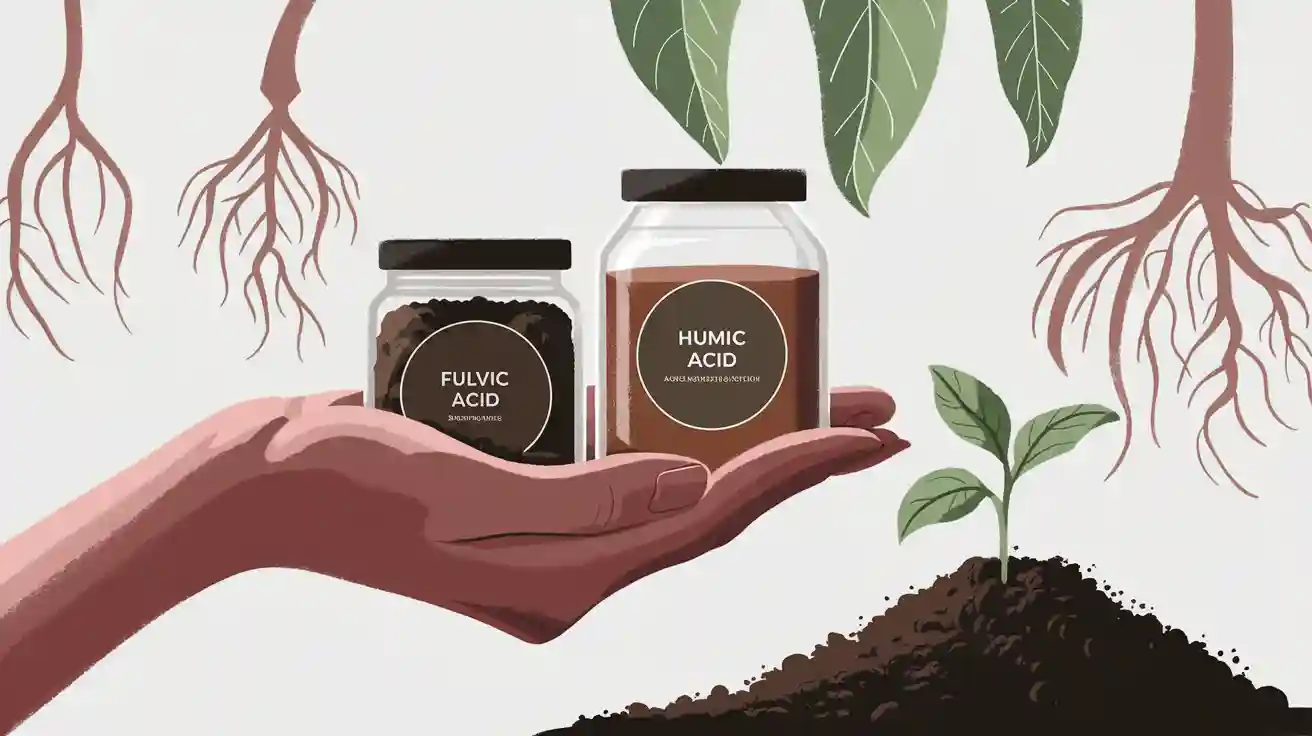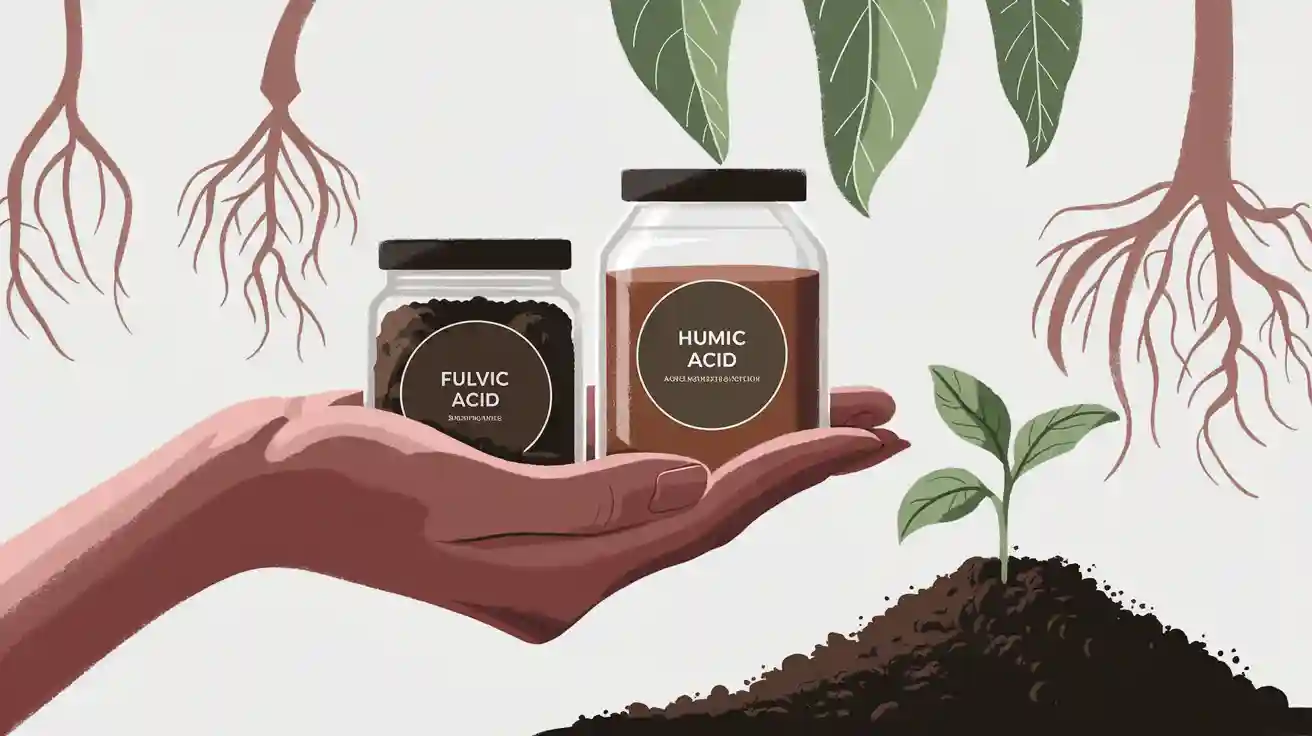
Fulvic acid humic acid both originate from old plant material in the soil, but they function differently. Fulvic acid humic acid is very small and water-soluble, aiding in nutrient transport into cells and supporting digestion. Humic acid, on the other hand, is larger and less water-soluble. It binds to harmful metals and promotes the growth of beneficial gut bacteria. Research shows that fulvic acid humic acid contribute to plant growth and improve soil quality.
- Fulvic acid humic acid can reduce inflammation and enhance mineral absorption in the body.
- Humic acid supports the proliferation of good gut bacteria and helps block toxins.
Overall, fulvic acid humic acid each play unique roles in benefiting both plants and humans.
Key Takeaways
- Fulvic acid and humic acid come from ancient plants. They help plants and soil grow in different ways. Fulvic acid is small and mixes easily with water. It helps move nutrients into plants and into the body. Humic acid is bigger and darker. It helps soil stay healthy by helping good microbes. It also blocks harmful toxins. Both acids help gut health by growing good bacteria. They also help the body take in minerals. People should follow the instructions on products. They should talk to a doctor before using supplements. This is very important if they have health problems.
Fulvic Acid Humic Acid Basics
What Is Fulvic Acid?
Fulvic acid is made when plants and animals break down in soil. It is part of a group called humic substances. Fulvic acid is very small and mixes well with water. This helps it move easily in soil and water. Its molecular weight is between 500 and 2,000 Daltons. Fulvic acid has many acidic groups. These groups give it a negative charge if the pH is above 3. Fulvic acid can look yellow or light brown.
Fulvic acid helps bring nutrients into plant cells. It can also stick to metals and make them less dangerous. Fulvic acid helps clean up the environment by removing heavy metals from dirty soil and water. Studies show fulvic acid helps plants grow better and take in more nutrients. It also helps crops like pistachios, peppers, and wheat fight stress and have more nutrients.
The table below lists some main properties of fulvic acid:
| Property | Value / Range | Details |
|---|---|---|
| Dissolved Organic Carbon (DOC) | ±0.5 mg-C L⁻¹ | Measured as nonpurgeable organic carbon |
| Elemental Composition | C: ±0.08%, H: ±0.04%, N: ±0.01%, O: ±0.01%, S: ±0.04% | Based on elemental analysis; ash content 0.5–4% |
| Ash Content | 0.5% to 4% | Part of sample mass |
| Molecular Weight | 500–2,000 Da | Polydisperse; weight-average MW |
| Acidic Functional Groups | Carboxylic (COOH), phenolic (OH) | Weak acid polyelectrolyte behavior |
| Point of Zero Charge | ~3 | Negatively charged at pH > 3 |
What Is Humic Acid?
Humic acid is another natural compound from old plants and animals in soil. It is bigger than fulvic acid and does not mix well with water, especially if the pH is low. Humic acid looks dark brown or black. Its size is usually smaller than fulvic acid in water, but it forms stronger particles in alkaline conditions.
Humic acid is made of many small molecules. These include fatty acids, ethers, esters, alcohols, aromatic fragments, polysaccharides, and peptides. It has many groups like quinones, phenols, carboxylic, and hydroxyl. These groups help humic acid stick to metals and toxins. The properties of humic acid depend on where it comes from and how it is taken out. Humic acids from rocks have more aromatic carbon and are more hydrophobic. Humic acids from soil and compost have more alkyl and methoxyl carbons.
- Humic acid can make soil better and help plants grow. It also helps good microbes and sticks to harmful metals and toxins. This lowers their bad effects on plants and animals. Studies show humic acid can change plant hormones and help roots grow. More hydrophobic humic acid types help plants even more.
Key Differences
Fulvic acid and humic acid are alike in some ways, but they are also different. They have different properties, sources, and effects. The table below shows their main differences:
| Property | Fulvic Acid | Humic Acid |
|---|---|---|
| Color | Yellow to light brown | Dark brown to black |
| Solubility | Soluble in water at all pH levels | Insoluble in water at low pH; soluble in alkaline solutions |
| Molecular Size (in water) | 500–1,200 nm (submicroparticles) | 300–600 nm (submicroparticles) |
| Molecular Weight | 500–2,000 Da | Variable; often smaller in water |
| Particle Stability | Less stable in water; more stable at higher pH | More stable; higher colloidal stability |
| Functional Groups | Carboxylic, phenolic | Quinones, phenols, carboxylic, hydroxyl |
| Source Variation | Higher O-alkyl and carboxyl/amide carbons | More aromatic carbon (geochemical); more alkyl/methoxyl (soil/compost) |
| Effects | Moves nutrients, binds metals, boosts plant growth | Improves soil, binds toxins, supports microbes, changes plant hormones |
- Fulvic acid humic acid both come from breaking down organic matter. Their chemical makeup depends on where they come from and how they are taken out. Fulvic acid has more ionizable groups, which changes how it acts and is removed. Humic acid is more hydrophobic and has more aromatic carbon, especially from rocks.
To sum up, fulvic acid and humic acid each have special properties and uses. Fulvic acid is smaller, lighter, and mixes with water. It helps move nutrients and clean up the environment. Humic acid is bigger, darker, and does not mix well with water. It is good at sticking to things and helps soil and plants.
Sources and Formation

Natural Origins
Fulvic acid and humic acid form when plants and animals break down. Microbes in the soil help change dead leaves and roots into these acids. Forests, grasslands, and wetlands make different kinds of fulvic acid and humic acid. The soil, weather, and plants in a place change how these acids act.
Scientists use special tools to look at fulvic acid and humic acid from many places. They check things like size, weight, and chemical groups. These tests show that fulvic acid and humic acid can be different sizes and shapes. Where they form changes their structure. The table below shows some of these differences:
| Parameter | Fulvic Acid (FA) | Humic Acid (HA) |
|---|---|---|
| Particle populations detected | 1 to 3 | 1 to 3 |
| Particle size ranges | Nanoparticles, submicroparticles, macroparticles (≥1 μm) | Nanoparticles, submicroparticles, macroparticles (≥1 μm) |
| Submicroparticle diameter | Generally larger than humic acids | Smaller than fulvic acids |
| Colloidal stability (zeta potential) | Lower stability in water | Higher stability in water |
Environmental scientists also use chemical tests and patterns to see how fulvic acid and humic acid are unique in each place.
Extraction Methods
People get fulvic acid and humic acid from soil, peat, or coal. They use different ways to do this. The most common way uses a strong base, like sodium hydroxide, to pull out the acids. After this, acids help split fulvic acid from humic acid.
Newer ways make extraction faster and better. For example, microwave methods can get more humic acid and fulvic acid. This way is four times faster than shaking the mixture. Ultrasound helps get more humic acid from peat and helps collect hydrophobic fulvic acid. Some scientists use ozone or electricity to get even more out.
- Microwave and KOH-urea work well for natural carbon.
- Ultrasound is good for hydrophobic fulvic acid.
- Electricity also helps get more acid.
The Yates model helps scientists guess how much fulvic acid and humic acid they can get. These new ways make it easier to collect fulvic acid for farming, gardening, and health products.
Benefits
Plant and Soil Benefits
Fulvic acid and humic acid help plants and soil in many ways. Farmers and gardeners use them to make crops grow better. Fulvic acid helps plants get nutrients more easily. It moves minerals into plant cells. This makes plants absorb more nutrients. Humic acid makes soil structure better and helps roots grow strong. Both acids keep soil healthy and help plants handle stress.
Many studies show these acids help crops. For example, fulvic acid makes maize, wheat, and rice grow taller. It also helps roots grow and lets plants take in more nutrients. In barley, fulvic acid made plants up to 16% taller than those without it. Humic acid helps plants make more food and keeps soil steady. It turns on enzymes that help plants use carbon and nitrogen. This helps plants grow better.
| Crop / Parameter | Numerical or Observed Effect |
|---|---|
| Cannabis | Improved canopy uniformity, plant height, chlorophyll content, photosynthetic efficiency |
| Cucumber (hydroponic) | Increased uptake of N, P, K, Ca, Cu, Fe, Mg, Zn |
| Wild olive | Increased nitrogen content |
| Maize | Enhanced net photosynthesis, transpiration rates, intercellular CO2 concentration |
| Fulvic acid properties | Lower molecular weight and higher solubility enable better nutrient chelation and uptake |
| Humic acid effects | Activation of enzymes in carbon and nitrogen metabolism, increased nitric oxide production, improved root morphology |
| Stress conditions | Humic acid particularly effective under drought; fulvic acid effective chelator at low concentrations |
Fulvic acid and humic acid are most of the organic matter in soil. They make soil loose and stable, even when it is wet or dry. These acids help plants take in nutrients like nitrogen, phosphorus, iron, and zinc. Studies show fulvic acid gives crops more antioxidants and better nutrition. Humic acid helps roots grow and lets plants live in poor or dry soil.
Many farmers say their crops are healthier and bigger after using fulvic acid and humic acid. These good results come from better nutrient use, stronger soil, and tougher roots.
Human Health Benefits
Fulvic acid and humic acid can help people stay healthy. Scientists have studied how they help the immune system, brain, and body. Fulvic acid helps the body take in minerals like calcium, iron, and iodine. In animal tests, minerals with fulvic acid got into the blood twice as fast as minerals alone. This means people may get more nutrients from food.
Humic acid has helped people in medical studies. In one study, people with IBS took humic acid. They felt better and had a better life. There were no bad side effects, and humic acid was safe to eat. Other studies show humic acid can lower swelling and help the immune system. It does this by raising CD4+ cells and turning on immune responses.
| Aspect | Details |
|---|---|
| Study Design | Randomized, double-blind, placebo-controlled clinical trial (WH67®-R-2012) |
| Intervention | Humic acids (Activomin®) vs placebo |
| Patient Population | Patients with IBS-D diagnosed by Rome III criteria, age ≥18, with symptoms at least twice in 2 weeks |
| Outcome Measures | IBS Severity Scoring System (IBS-SSS), IBS Quality of Life (IBS-QOL), Bristol Stool Form Scale (BSFS) |
| Results Summary | Significant improvement in IBS symptoms and quality of life with humic acid treatment, no known side effects, low oral toxicity |
Fulvic acid and humic acid may also help the brain. Some studies say they protect brain cells and help memory. Scientists are still learning about this, but early results are good. Both acids may lower cholesterol and help the gut, which is good for the brain too.
Note: Many studies show good health effects, but scientists need to do more research to know how fulvic acid and humic acid work in people.
Digestive Health
Digestive health is important for feeling good. Fulvic acid and humic acid help keep the gut healthy. They help good bacteria grow and help the body use nutrients. Studies show humic acid raises the amount of gut bacteria by over 30%. Good bacteria groups go up by 14%, and some groups rise by 96%. These changes make the gut healthier.
| Parameter | Effect of Humic Acid Supplementation | Statistical Significance |
|---|---|---|
| Mean concentration of colonic microbiome | Increased by >30% overall | P < 0.001 |
| Essential bacterial groups | Increased by 14% | P < 0.01 |
| Individual substantial bacterial groups | Increased by 41% | P < 0.002 |
| Most bacterial groups within essential, pioneer, and substantial sets | Increased by 20%-60% | Observed from day 10 to day 45 |
Fulvic acid also helps the gut by raising good bacteria. In animal tests, fulvic acid made more Lactococcus and Lactobacillus. These are important for a healthy gut. Fulvic acid made digestive enzymes work better. It helped animals digest protein and minerals. In pigs, fulvic acid helped them use more phosphorus and ash.
Humic substances help keep the right pH in the gut. This helps food break down and stops bad bacteria. They also help the immune system by making cells eat germs and turning on genes that protect the gut. Some studies show humic acid and fulvic acid help the gut and immune system, which helps the whole body.
Scientists are still studying how fulvic acid and humic acid help digestion. Most results are good, but more research will show how these acids work in the gut.
Humic Acid Supplement Use
How to Use
People can buy humic acid supplement products in different forms. These forms are powders, capsules, and liquid drops. Some people mix the powder with water or juice. Others take capsules when they eat food. Liquid drops can go in drinks or under the tongue. Every product has its own set of instructions. Users should always check the label and do what it says. Many companies also sell fulvic acid supplement products. Sometimes, fulvic acid and humic acid are mixed together in one product.
Farmers and gardeners use humic acid supplement products for their plants and soil. They mix the supplement with water and spray it on crops. Some add it to irrigation systems. This helps plants get more nutrients and makes soil better. People should not use more than the amount listed on the label. Using too much can hurt plants or waste the product.
Safety and Side Effects
Scientists have not studied humic acid supplement use in humans enough. Most research is on animals or small groups of people. Trusted sources like RxList and WebMD say there is not enough information about safe doses or side effects. There are no big reviews or studies that look at these supplements.
- Some reports say humic acid supplement use may cause joint, blood flow, or thyroid problems. These reports do not show strong proof or clear patterns.
- Pregnant or breastfeeding women should not use these supplements. People with autoimmune diseases should also avoid them. Humic acid may change how the immune system works and cause trouble for these people.
- No one knows what happens if people use humic acid supplement products for a long time.
Tip: People should talk to a doctor before starting any new supplement. This is extra important if they have health problems or take other medicines.
Fulvic acid and humic acid help plants, soil, and people in different ways. Fulvic acid is smaller and mixes with water easily. Humic acid is bigger and looks darker. New research says fulvic acid is safe and can lower swelling. If there are mild side effects, they go away fast. People new to these acids should use them as the label says and not take too much. If they have questions about using supplements or for soil, they should talk to a doctor or gardening expert.
FAQ
What is the main role of fulvic acid and humic acid in the gut?
Fulvic acid and humic acid help the gut by supporting good bacteria. They improve how the gut absorbs nutrients. These acids also help the gut fight harmful substances and keep the gut lining healthy.
Can fulvic acid and humic acid help with gut problems?
Many people use these acids to support gut health. Studies show they may help with gut issues like bloating or discomfort. They can help balance the gut bacteria and make the gut work better.
How do fulvic acid and humic acid affect gut bacteria?
These acids increase the number of good bacteria in the gut. They help the gut grow more helpful bacteria. This change can make the gut stronger and help the gut fight off bad germs.
Are there any side effects on the gut from using these acids?
Most people do not have gut side effects when using these acids. Some may notice mild gut changes, like softer stools. If the gut feels upset, people should stop use and talk to a doctor.
Should people with gut diseases use fulvic acid or humic acid?
People with gut diseases should ask a doctor before using these acids. The gut may react differently in each person. Doctors can help decide if these acids are safe for the gut.




